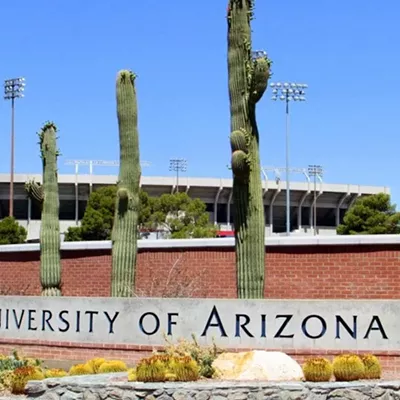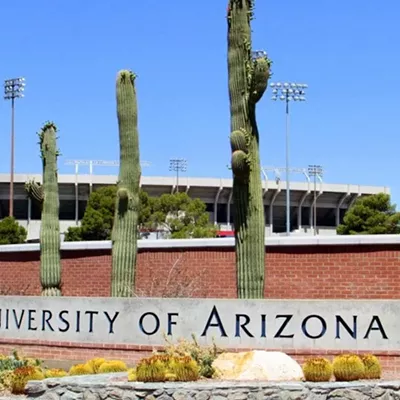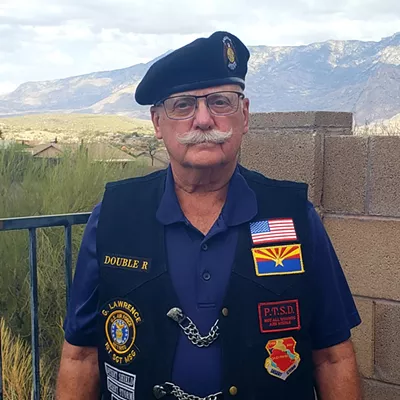The UA does devote a disproportionate amount of resources to help the 758 American-Indian students assimilate into college life. In fact, UA's College of Public Health ranks first in American-Indian students enrolled among 33 universities nationwide, and UA President Peter Likins' support of American Indians goes so deep that he personally adopted and raised some Indian children.
But when UA's American-Indian graduate students returned from summer break, they found something missing: The popular American Indian Graduate Center building at Helen Street and Vine Avenue had been turned into a parking lot.
"I was disappointed that they basically put the grad center in a room and got rid of the house," says history graduate student Luke Ryan, a Cherokee from Oklahoma.
The grad center is now located with Native American Student Affairs (NASA), on the second floor of the Nugent Building.
"We knew it would be a disappointment to some students, and we worked hard to get the best possible space," says Lynette Cook Francis, assistant vice president of Multicultural Affairs and Student Success.
"I would have screamed and hollered if I hadn't graduated," says Lee Jackson, past president of the UA Powwow Committee and recent American Indian Studies graduate. "My class was the last class that came through there, and we all felt fortunate we had it while we were here."
Established in 1988, the American Indian Graduate Center is the only known center in the country established by a university with the sole purpose of providing support for American-Indian graduate students.
And support is what UA's American Indian student body needs the most.
A 17-year student retention study found that the freshman retention rate was 77 percent, with the overall graduation rate at 52 percent. And American-Indian students had the lowest retention rate of any group, with only 61 percent of freshmen returning for their sophomore year--and only 20 percent graduating.
While UA provides an alphabet soup of American-Indian student support organizations and clubs, the Indian grad students feel second-class with the loss of their grad center, which provided a home-like gathering place for a variety of American-Indian student groups. The converted, two-story house offered a kitchen, 24-hour keypad access and outdoor patio area--site of many campus and Indian community celebrations honoring such groups as the Navajo Code Talkers.
"They won't be able to have things like that at the Nugent Building," says Jackson, a member of the Chumash tribe of Southwestern California. "If they could not have found another place for the parking lot, I think, since they own a lot of real estate, they could have found another place that was at least equal to Helen Street for the grad center to move to."
The UA's Francis notes that other buildings on the street were also razed. "This move actually had nothing to do with our department. Space issues here are not determined by the individual departments, especially issues like this."
Says Mercy Valencia, director of UA Space Management: "We certainly didn't have any residential properties that had anywhere near that kind of yard, or size."
It's not the first time the Indian grad students have lost their homey digs. The original center was in a house on Seventh Street, but the UA decided to sell it. It was only by the efforts of then-grad center director Glenn Johnson that the students acquired another house from the UA Graduate College, which oversaw the center at the time.
"I think the political culture of the UA has changed," says Ryan. "American Indian students actually lobbied to have an Indian graduate center, and they were successful. It was a student initiative. I don't know what it is, but now they've lost that type of power for a whole host of reasons."
Despite protests and meetings with the administration, that clout evaporated two years ago when Glenn Johnson was fired, and UA administration consolidated the grad center with NASA under the Department of Multicultural Programs and Services.
"That defeats the original intent of why the center was created," says Ryan. "It was supposed to be a place where they had their own director and it met the certain specific needs of Indian grad students--a very underrepresented grad population. I think that Indian grad students have a different need than undergraduates, and the NASA program doesn't really think we have special needs."
Adds Ryan, "There are going to be people who feel isolated, and that's one of the reasons they leave the university. They don't meet people who are from where they come from; that's one of the reasons the Indian grad center was founded."
Francis says the Nugent building will still offer the support of the old house, "So students who are just coming probably think, 'Wow, this is a great space.' The students who were accustomed to having the run of a private home--it feels like a loss."









